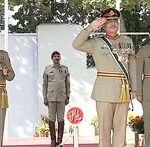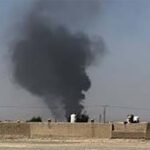
INSIDE RUSSIA
Lavrov discusses Russia-US dialogue, Ukraine crisis with envoys of Eurasian states
During the meeting, the sides exchanged views on issues related to the implementation of the initiative put forward by Russian President Vladimir Putin to create a new security architecture in Eurasia with the participation of all states of the continent and their associations
Russian Foreign Minister Sergey Lavrov has discussed international issues, including Moscow’s renewed dialogue with Washington and the Ukrainian crisis, at a meeting with the ambassadors of Eurasian countries, the Foreign Ministry said on its website following the meeting.
“The discussion also covered other key items on the international agenda, including the state of the Russian-American dialogue and the settlement of the Ukrainian crisis,” the foreign ministry said
During the meeting, the sides exchanged views on issues related to the implementation of the initiative put forward by Russian President Vladimir Putin to create a new security architecture in Eurasia with the participation of all states of the continent and their associations. “During the discussion, the need to ensure stability in the Eurasian space, application of the principle of indivisibility of security in practice and ensuring the primary responsibility of the Eurasian states for solving Eurasian problems was emphasized,” the ministry said.
The meeting participants also noted the importance of the international conference organized annually in Minsk for holding a serious discussion on Eurasian security. Lavrov drew attention to “the initiative put forward by the Republic of Belarus and supported by the Russian Federation to prepare the Eurasian Charter for Diversity and Multipolarity in the 21st Century, a policy document that could outline the framework parameters of the continental security architecture.”
Lavrov describes situation in Middle East as ‘explosive’
The top Russian diplomat also said the Euro-Atlantic security paradigm was in crisis, and drew attention to the dangerous actions of NATO states aimed at destabilizing the situation in the Asia-Pacific region
Russian Foreign Minister Sergey Lavrov called the situation in the Middle East “explosive” and pointed to the threats to stability of the South Caucasus and Central Asia, the Foreign Ministry said after his meeting with the heads of diplomatic missions of some Eurasian states accredited in Russia.
“In his opening remarks, the minister gave fundamental assessments of the security situation in various parts of Eurasia,” the ministry said.
He said the Euro-Atlantic security paradigm was in crisis, and drew attention to the dangerous actions of NATO states aimed at destabilizing the situation in the Asia-Pacific region, the explosive situation in the Middle East, and the risks to the stability of the South Caucasus and Central Asia.
Russian, Bangladesh military officials discuss cooperation
The Russian Defense Ministry said the sides “expressed mutual determination to further strengthen the existing friendly relations between the armies and peoples of Russia and Bangladesh”
Russian Deputy Defense Minister Col. Gen. Alexander Fomin and Bangladeshi Chief of Army Staff Gen. Waker-Uz-Zaman have met to discuss prospects of military cooperation, the Russian Defense Ministry said.
“On April 7, 2025, Russian Deputy Defense Minister Col. Gen. Alexander Fomin and Bangladeshi Chief of Army Staff Gen. Waker-Uz-Zaman held a working meeting in Moscow as part of the latter’s visit to the Russian Federation,” the statement says.
The Russian Defense Ministry said the sides “discussed prospects for cooperation in the defense sector and expressed mutual determination to further strengthen the existing friendly relations between the armies and peoples of Russia and Bangladesh.”
“The meeting was held in a warm and friendly atmosphere,” the ministry added.
Russia’s international reserves up by 2.37% in March to $647.358 bln — Central Bank
On April 1, 2024, Russia’s international reserves amounted to $590.374 billion
Russia’s international reserves amounted to $647.358 billion as of April 1, 2025, having increased by $15.003 bln (or by 2.37%) since the beginning of March, the Central Bank said in a statement.
On April 1, 2024, Russia’s international reserves amounted to $590.374 billion.
In March 2025, foreign exchange reserves increased by 0.83% to $418.407 bln, while the value of monetary gold in reserves increased by 5.32% to $228.95 bln.
Russia’s international reserves are highly liquid foreign assets available with the Bank of Russia and the Russian Government. They comprise foreign currency, Special Drawing Rights (SDRs), a reserve position in the International Monetary Fund and monetary gold
Western countries introduced sanctions against the Bank of Russia after the start of the special operation in Ukraine. In addition to freezing the gold and foreign exchange reserves of the Russian Federation, all operations related to the management of the reserves and assets of the Bank of Russia, as well as operations with any legal entity, organization acting on behalf of or at the request of the Bank of Russia were banned.
OUTSIDE RUSSIA
Russian companies eye oil and gas projects in Equatorial Guinea — Energy Ministry
The parties are also considering the introduction of industry standards of the Institute of Oil and Gas Technological Initiatives for equipment and technology
Russian companies are interested in developing projects in the oil and gas sector in Equatorial Guinea, the Russian Energy Ministry reported following a meeting between Deputy Minister Roman Marshavin and the Ambassador of the African country NdongAyekaba.
“The Deputy Minister noted that Russian companies are interested in developing projects in the oil and gas sector in the republic,” the ministry said.
The parties are also considering the introduction of industry standards of the Institute of Oil and Gas Technological Initiatives for equipment and technology.
They also touched upon training personnel for the republic’s energy sector. The African side expressed interest in organizing training programs at Russian universities.
“Many countries are turning to Russia to train personnel in the energy sector. Despite the fact that Russia already trains a significant number of students, the need for personnel is much greater,” Roman Marshavin said.
Russian oil and gas companies and Equatorial Guinea
Earlier, the country’s Minister of Mining and Hydrocarbons Antonio Oburu Ondo said that the country was interested in attracting partners from Russia to develop oil and diamond deposits. According to him, Equatorial Guinea is counting on the interest of Lukoil and other Russian oil and gas companies in oil projects in the country.
The minister noted that Lukoil participated in the licensing round for sites in Equatorial Guinea in 2019, but it was unsuccessful for all companies. In addition, that year Lukoil and Rosgeo signed memorandums of understanding with the Ministry of Mining and Hydrocarbons of Equatorial Guinea.
Reportedly, Rosneft, Lukoil and Gazprom were interested in the project to develop the Fortuna gas field.
Russia seeks to increase its contribution into UN peacekeeping activities
“Russia is making its contribution into the training of military peacekeepers, including foreigners, in accordance with training programs for staff officers and military observers certified by the UN Secretariat,” Russian Deputy Permanent Representative to the UN Anna Yevstigneyeva noted
Russia is paying effort to increase its contribution into the peacekeeping activities of the United Nations, Russian Deputy Permanent Representative to the UN Anna Yevstigneyeva said.
“The Russian Federation, as a contributor of military contingents, is seeking to increase its contribution into the UN’s peacekeeping activities. At present, under the auspices of the Defense Ministry, military observers and staff officers are fulfilling their duty in [peacekeeping] missions in the Central African Republic, West Sahara, Democratic Republic of the Congo, Middle East, South Sudan and Cyprus,” she told a UN Security Council meeting on peacekeeping operations.
“Russia is making its contribution into the training of military peacekeepers, including foreigners, in accordance with training programs for staff officers and military observers certified by the UN Secretariat. Our country has unique expertise in the professional training of blue helmets, which we are ready to share,” she said.
Russian, Tajik troops kick off joint counter-terror drills in Tajikistan
The active phase of the drills will run on April 7-11
Russian and Tajik troops have kicked off joint counter-terror drills at the Kharb-Maidon mountain and desert practice range in the south of Tajikistan, the press office of Russia’s Central Military District told TASS o Monday.
The drills began with a line-up of Russian and Tajik troops on the training ground and the military bands performed the anthems of both countries. National flags were raised followed by a solemn march of the troops on a field camp. The active phase of the drills will run on April 7-11, it said.
“During the exercise, the military contingents from both countries will practice employing armed formations to destroy terrorist gangs and preparing units for accomplishing assigned objectives on mountainous terrain. The basic phase will involve a joint operation to eliminate illegal armed gangs and exercise command and control of troops in protecting the state border and eliminating the infiltrated armed gangs,” the press office said in a statement.
The Russian military contingent involved in the drills comprises units of Russia’s 201st military base stationed in Tajikistan: mountain, motor rifle, tank, artillery and reconnaissance troops, the crews of an air task force flying Mi-24 attack helicopters and Mi-8MTV-5 combat/transport rotorcraft, it specified.
The joint military maneuvers will also involve signal troops, operators of strike FPV drones and reconnaissance UAVs and mobile electronic warfare groups, it said.
SPECIAL MILITARY OPERATION IN UKRAINE
Russian troops liberate Katerinovka community in Donetsk region over past day
Russia’s Battlegroup West inflicted roughly 215 casualties on Ukrainian troops and destroyed three enemy artillery guns in its area of responsibility over the past day
Russian troops liberated the community of Katerinovka in the Donetsk region over the past day in the special military operation in Ukraine, Russia’s Defense Ministry reported on Monday.
“Battlegroup West units liberated the settlement of Katerinovka in the Donetsk People’s Republic through decisive operations,” the ministry said in a statement.
Russia’s Battlegroup North inflicts over 85 casualties on Ukrainian army in past day
Russia’s Battlegroup North inflicted more than 85 casualties on Ukrainian troops and destroyed an enemy armored combat vehicle in its area of responsibility over the past day, the ministry reported.
“In the Belgorod direction, Battlegroup North units inflicted losses on formations of two mechanized brigades, an assault regiment of the Ukrainian army and a territorial defense brigade in areas near the settlements of Miropolskoye, Prokhody, VelikyPrikol and Osoyevka in the Sumy Region,” the ministry said.
The Ukrainian army lost more than 85 personnel, an armored combat vehicle and two motor vehicles in that frontline area over the past 24 hours, it specified.
Russia’s Battlegroup West inflicts 215 casualties on Ukrainian army in past day
Russia’s Battlegroup West inflicted roughly 215 casualties on Ukrainian troops and destroyed three enemy artillery guns in its area of responsibility over the past day, the ministry reported.
During the last 24-hour period, Battlegroup West units “inflicted losses on manpower and equipment of two mechanized brigades of the Ukrainian army and a territorial defense brigade in areas near the settlements of Kondrashovka, Kupyansk and Shiykovka in the Kharkov Region, Novoye and Kirovsk in the Donetsk People’s Republic,” the ministry said.
The Ukrainian army lost an estimated 215 personnel, three artillery guns and an electronic warfare station in that frontline area over the past 24 hours, it specified.
In addition, Russian forces destroyed an ammunition depot of the Ukrainian army, it said.
Russia’s Battlegroup South inflicts 300 casualties on Ukrainian army in past day
Russia’s Battlegroup South inflicted roughly 300 casualties on Ukrainian troops and destroyed two enemy ammunition depots in its area of responsibility over the past day, the ministry reported.
“Battlegroup South units improved their tactical position and inflicted losses on formations of seven mechanized brigades of the Ukrainian army and a territorial defense brigade in areas near the settlements of Seversk, Minkovka, ChasovYar, Konstantinovka, Artyom, Kalinovo and Tarasovka in the Donetsk People’s Republic,” the ministry said.
The Ukrainian army lost an estimated 300 personnel, two armored combat vehicles, including a US-made M113 armored personnel carrier, 22 motor vehicles and an electronic warfare station in that frontline area over the past 24 hours, it specified.
In addition, Russian forces destroyed two ammunition and two materiel depots of the Ukrainian army, it said.
Russia’s Battlegroup Center inflicts 440 casualties on Ukrainian army in past day
Russia’s Battlegroup Center inflicted roughly 440 casualties on Ukrainian troops and destroyed an enemy tank and three armored combat vehicles in its area of responsibility over the past day, the ministry reported.
“Battlegroup Center units gained better lines and positions and inflicted damage on manpower and equipment of three mechanized and two infantry brigades, an airborne brigade, an assault brigade, an unmanned systems brigade, an assault regiment, an unmanned aircraft systems regiment of the Ukrainian army, a marine infantry brigade and a National Guard brigade in areas near the settlements of Yelizavetovka, Dimitrov, Krasnoarmeysk, Zverevo, Kotlino, Udachnoye, Lenina, Novosergeyevka, Kotlyarovka and Bogdanovka in the Donetsk People’s Republic,” the ministry said.
The Ukrainian army lost an estimated 440 personnel, a tank, three armored combat vehicles, including a US-made MaxxPro armored vehicle and seven motor vehicles, it specified.
In addition, Russian forces destroyed three field artillery guns and an ammunition depot of the Ukrainian army, it said.
Russia’s Battlegroup East inflicts 140 casualties on Ukrainian army in past day
Russia’s Battlegroup East inflicted roughly 140 casualties on Ukrainian troops and destroyed three enemy artillery guns in its area of responsibility over the past day, the ministry reported.
“Battlegroup East units continued advancing deep into the enemy’s defenses and inflicted losses among manpower and equipment of two mechanized brigades, a mountain assault brigade of the Ukrainian army and a territorial defense brigade in areas near the settlements of Poddubnoye, Komar, Burlatskoye and Volnoye Pole in the Donetsk People’s Republic,” the ministry said.
The Ukrainian army lost an estimated 140 personnel, an armored combat vehicle, two motor vehicles and three field artillery guns, including a Polish-manufactured 155mm Krab self-propelled artillery system and a US-made 155mm M777 howitzer in that frontline area over the past 24 hours, it specified.
Russia’s Battlegroup Dnepr destroys 70 Ukrainian troops in past day
Russia’s Battlegroup Dnepr destroyed roughly 70 Ukrainian troops and an enemy armored combat vehicle in its area of responsibility over the past day, the ministry reported.
“Battlegroup Dnepr units improved their tactical position and inflicted losses on formations of a mechanized brigade, a mountain assault brigade, two coastal defense brigades of the Ukrainian army and a territorial defense brigade in areas near the settlements of Novodanilovka and Pavlovka in the Zaporozhye Region, Sadovoye and Ponyatovka in the Kherson Region,” the ministry said.
“As many as 70 [Ukrainian] military personnel, an armored combat vehicle and three motor vehicles were destroyed,” it said.
Russian forces strike Ukrainian UAV control posts, artillery depots in past day
Russian forces struck Ukrainian UAV (unmanned aerial vehicle) control posts, missile and artillery armament depots over the past day, the ministry reported.
“Operational/tactical aircraft, attack unmanned aerial vehicles, missile troops and artillery of the Russian groups of forces struck UAV control posts, missile and artillery armament depots and massed manpower and equipment of the Ukrainian army in 137 areas,” the ministry said in a statement.
Russian air defenses down 95 Ukrainian UAVs, three HIMARS rockets over past day
Russian air defense forces shot down 95 Ukrainian unmanned aerial vehicles and three US-made HIMARS rockets over the past day, the ministry reported.
“Air defense capabilities shot down three rockets of the US-made HIMARS multiple launch rocket system and 95 fixed-wing unmanned aerial vehicles,” the ministry said.
Overall, the Russian Armed Forces have destroyed 660 Ukrainian warplanes, 283 helicopters, 50,177 unmanned aerial vehicles, 601 surface-to-air missile systems, 22,710 tanks and other armored combat vehicles, 1,534 multiple rocket launchers, 23,320 field artillery guns and mortars and 33,750 special military motor vehicles since the start of the special military operation, the ministry reported.
INSIGHTS
Rosoboronexport: Pioneering New Defense Ventures with Global South
The Russian state arms exporter told Sputnik it is in talks with partners across Latin America, the Asia Pacific, Africa, the Middle East and the CIS on more than 100 cutting-edge defense projects.
Rosoboronexport’s technological cooperation with Global South nations on products for all types of armed forces boasts a potential of over $30 billion.
Projects focus on:
- Small arms and ammunition
- Advanced air defense systems
- Multi-purpose helicopters, including the Ka-226T
- Su-57E fighter jets and aircraft engines
- State-of-the-art air-to-air missiles
UAVs like the Orlan-10E, Orlan-30 and Orion-E and next-generation loitering munitions such as the Kub series.
Electronic warfare technology to down enemy drones
Foreign clients are “interested in everything that’s being used in the special operation zone,” Rosoboronexport told Sputnik. What are Russia’s most popular arms exports?
Rosoboronexport hosted talks with a number of delegations at the recent International Latin American Exhibition of Aviation and Defense Systems LAAD 2025, hosted by Brazil from April 1 to 4. Discussions focused on the joint production of Russian defense products, with a stress on manufacturing in partner countries.
Western Military and Aerospace Systems With a Russian Twist
UK media were enraged to learn of plans to replace the RAF Red Arrows’ British-built Hawk T1 jets with the M-346, an advanced trainer developed by Russia’s Yakovlev and Italy’s Aermacchi in the 90s out of the Yak-130.
Ex-RAF instructor Tim Davies told The Sun replacing the Hawk with a plane based on a Russian design would border on ‘treason.’
He would likely be horrified to learn that a whole array of Western weapons and aerospace products were created jointly with Russia, or on the basis of Soviet and Russian designs:
Mistral
A Russian-French collaboration taking a French amphibious assault ship and adapting it to integrate Russian weaponry, communications, and command and control systems, and to carry Ka-52 assault helicopters. The deal was scrapped by Paris in 2015, but the two Mistrals originally meant for Russia were sold to Egypt, complete with complements of Ka-52s.
Mil Mi-17
Sturdy and reliable utility helicopters that NATO fell in love in with after its invasion of Afghanistan. NATO forces and allies adapted the choppers to include Western avionics, GPS, radar, thermal imaging, targeting pods and secure communications, armor kits, and even weapons like M134 miniguns and FN Herstal 7.62mm door guns.
RD-180 Rocket Engines
Derived from the Soviet Energia heavy lift launch vehicle, these efficient, ultra-reliable Russian engines were created in the 2000s for use by the US Atlas III and V launch vehicles. Fast forward to 2025, and while new purchases of RD-180s has been stopped, the US still has a stock of them for the launch of critical national security-related equipment into orbit.
F-35B Jets
The STOVL variant of the US military’s troubled F-35 was developed from the Yak-141, a Soviet carrier-based fighter design with thrust-vectoring engine, vertical lift fan and vectorable exhaust nozzle tech. Lockheed Martin bought Yak-141 blueprints in the 1990s, adopting them for use in the new plane.






